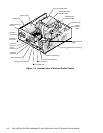
System Overview 1-3
&KDVVLV6LPLODULW LHV
All four chassis configurations have the following similarities:
The same system board.
Identical operational characteristics (same BIOS, POST, memory,
microprocessor, external I/O ports, and so on).
Identical diagnostics, diagnostic beep codes, and diagnostic-screen error
messages (see Chapters 1 through 3 and Appendix A). However, the
OptiPlex NX1 computer has no built-in diskette drive and requires a
special setup process to run the diskette-based diagnostics as described
in Chapter 2.
6WDQGDUG)HDWXUHV
The features described in the following subsections are common to all chassis
configurations.
3 HQWLXP,,0LFURSURFHVVRU
All systems in the OptiPlex GX1/GX1p and OptiPlex NX1 computer families
incorporate the Pentium II microprocessor for improved operating speeds and
overall performance. Some of the major enhancement features of the
Pentium II microprocessor include internal 16-KB data and instruction caches,
internal math coprocessor, and the MMX instruction set for high performance
in complex multimedia and communications environments. The Pentium II
microprocessor also uses a technique called single instruction, multiple data
(SIMD), which permits processing data elements in parallel for additional sys-
tem performance enhancement.
The microprocessor is physically located in a single-edge contact (SEC)
cartridge/heat sink assembly on the system board for ease of upgrading when
faster processors are available. Contact Dell Computer Corporation for informa-
tion about Dell-supported microprocessor upgrades.
6HFRQGDU\/&DFKH
For additional performance, the OptiPlex GX1/GX1p and OptiPlex NX1 systems
employ a secondary cache memory subsystem with a cache memory control-
ler and 512 KB of pipeline-burst SRAM cache memory. The L2 cache SRAM is
located in the SEC cartridge/heat sink assembly on the system board.





















